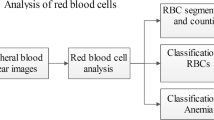Abstract
Identifying parasite species and their stage is very important in scrutinizing the properties of malaria, and preventing as well as diagnosing it. Unfortunately, it is a labor-intensive and time-consuming task. Moreover, the diagnosis accuracy heavily depends on the experience and skill of the technician, whose training is expensive. Developing a computer-aided system is thus necessary for identifying parasite species and their stage for malaria diagnosis. Extracting the infected erythrocytes and parasites from a blood smear image is essential for such as system. The present study proposes an automatic malaria parasite detector for segmenting parasites and malaria-infected erythrocytes from a blood smear image. This detector can objectively and efficiently help a doctor diagnose malaria. Experimental results show that the proposed detector performs well in segmenting parasites and malaria-infected erythrocytes from a blood smear image taken under a microscope.










Similar content being viewed by others
References
World Health Organization. (2014). World Malaria Report 2014. Geneva: World Health Organization.
Trampuz, A., Jereb, M., Muzlovic, I., & Prabhu, R. M. (2003). Clinical review: Severe malaria. Critical Care, 7, 315–323.
Zhou, Z., Wu, S., Chang, K. J., Chen, W. R., Chen, Y. S., Kuo, W. H., et al. (2015). Classification of benign and malignant breast tumors in ultrasound images with posterior acoustic shadowing using half-contour features. Journal of Medical and Biological Engineering, 35, 178–187.
Chiodini, P. L., Moody, A. H., & Manser, D. W. (2001). Atlas of medical helminthology and protozoology (4th ed.). New York: Edinburgh, Churchill Livingstone.
Cross, C. (2004). Malaria control measure, November 2004. http://malaria.wellcome.ac.uk/doc_WTD023987.html.
Gelasca, E. D., Byun, J., Obara, B., & Manjunath, B. S. (2008). Evaluation and benchmark for biological image segmentation. In 15th IEEE international conference on image processing, San Diego, CA (pp. 1816–1819).
Le, M. T., Bretschneider, T. R., Kuss, C., & Preiser, P. R. (2008). A novel semi-automatic image processing approach to determine Plasmodium falciparum parasitemia in giemsa-stained thin blood smears. BMC Cell Biology, 9, 15.
Payne, D. (1988). Use and limitations of light microscopy for diagnosing malaria at the primary health care level. Bulletin of the World Health Organization, 66(5), 621–626.
Ross, N. E., Pritchard, C. J., Rubin, D. M., & Dusé, A. G. (2006). Automated image processing method for the diagnosis and classification of malaria on thin blood smears. Medical & Biological Engineering & Computing, 44(5), 427–436.
Ruberto, C. D., Dempster, A., Khan, S., & Jarra, B. (2002). Analysis of infected blood cell images using morphological operators. Image Vision Computing, 20(2), 133–146.
Sio, S. W. S., Sun, W., Kumar, S., Bin, W. Z., Tan, S. S., Ong, S. H., et al. (2007). MalariaCount: An image analysis-based program for the accurate determination of parasitemia. Journal of Microbiology Methods, 68(1), 11–18.
Zuiderveld, K. (1994). Contrast limited adaptive histogram equalization. In P. Heckbert (Ed.), Graphics gems IV (pp. 474–485). New York: Academic Press.
Case 206: Malaria falciparum. http://www.fujita-hu.ac.jp/~tsutsumi/case/case206.htm.
Perez-Jorge, E. V., & Herchline, T. (2014). Malaria: eMedicine infectious diseases. http://emedicine.medscape.com/article/221134-overview.
Hsu, W. Y., & Chen, K. W. (2014). Segmentation-based image compression using modified competitive network. Journal of Medical and Biological Engineering, 34(6), 542–546.
Moody, A. H., & Chiodini, P. L. (2000). Methods for the detection of blood parasites. Clinical and Laboratory Haematology, 22(4), 189–201.
Kumar, S., Ong, S. H., Ranganath, S., Ong, T. C., & Chew, F. T. (2006). A rule-based approach for robust clump splitting. Pattern Recognition, 39(6), 1088–1098.
Anggraini, D., Nugroho, A. S., Pratama, C., Rozi, I. E., Iskandar, A. A., & Hartono, R. N. (2011). Automated status identification of microscopic images obtained from malaria thin blood smears. In International conference on electrical engineering and informatics, Bandung (pp. 1–6)
Panchbhai, V. V., Damahe, L. B., Nagpure, A. V., & Chopkar, P. N. (2012). RBCs and parasites segmentation from thin smear blood cell images. International Journal of Image, Graphics and Signal Processing, 4(10), 54–60.
Nasir, A. S. A., Mashor, M. Y., & Mohamed, Z. (2013). Color image segmentation approach for detection of malaria parasites using various color models and k-means clustering. WSEAS Transaction on Biology and Biomedicine, 1(10), 41–55.
Shi, Y. Q., & Sun, H. (2008). Image and video compression for multimedia engineering fundamentals, algorithms, standards (2nd ed.). Boca Raton: CRC Press-Taylor & Francis Group.
Gonzalez, R. C., & Woods, R. E. (2008). Digital image processing (3rd ed.). Upper Saddle River, NJ: Prentice Hall.
Canny, J. (1986). A computational approach to edge detection. IEEE Transactions on Pattern Analysis and Machine Intelligence, 8(6), 679–698.
Nixon, M. S., & Aguado, A. S. (2002). Feature extraction and image processing (1st ed.). Oxford: Newnes.
Carlone, P., Palazzo, G. S., & Pasquino, R. (2007). Pultrusion manufacturing process development: cure optimization by hybrid computational methods. Computers & Mathematics with Applications, 53, 1464–1471.
Sezgin, M., & Sankur, B. (2004). Survey over image thresholding techniques and quantitative performance evaluation. Journal of Electronic Imaging, 13(1), 146–165.
Author's contributions
YKC and KCT conceived the study. YKC designed the approach and performed the computational analysis with YWH, CLW, CMW, LYT, CWL, and KCT. YKC and KCT supervised the work and tested the program. YWH, CMW, LYT, and CWL wrote the manuscript. KCT prepared the samples and collected the data together with YWH and CLW. YKC and KCT contributed analyzing experimental studies. All authors read and approved the final manuscript. YKC and KCT contributed equally and are the correspondent authors as well as listed in alphabetical order.
Author information
Authors and Affiliations
Corresponding authors
Rights and permissions
About this article
Cite this article
Hung, YW., Wang, CL., Wang, CM. et al. Parasite and Infected-Erythrocyte Image Segmentation in Stained Blood Smears. J. Med. Biol. Eng. 35, 803–815 (2015). https://doi.org/10.1007/s40846-015-0101-0
Received:
Accepted:
Published:
Issue Date:
DOI: https://doi.org/10.1007/s40846-015-0101-0




